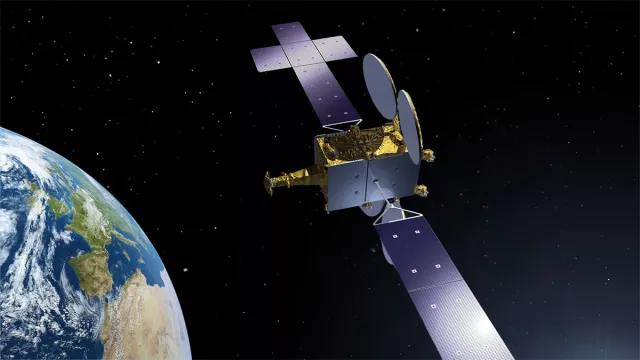The NEOSAT project aims to develop a new generation of spacecraft buses for telecommunications satellites in geostationary orbit delivering Internet and television services.
Key information
| Mission | Boost the competitiveness of Europe’s geostationary telecommunications satellite industry |
|---|---|
| Domain | Telecoms, navigation |
| Start date | 2011 |
| Partners | Airbus Defence & Space, Thales Alenia Space |
| Where | Geostationary orbit |
| Lifetime | 11 years |
| Status | Completed |
Key figures
- 30% reduction in satellite mass through use of all-electric propulsion
- Up to 25 kW delivered by bus
- Up to 2 tonnes of payload mounted on bus
- 30% reduction in cost of orbital capacity
Key milestones
- 07/2011: Project kick-off
- 10/2014: Spacebus Neo PDR
- 12/2014: Eurostar NEO PDR
- 07/2017: Spacebus Neo CDR
- 05/2019: Eurostar NEO CDR
- 01/2020: Launch of EUTELSAT KONNECT: first satellite built around Spacebus Neo 100
- 10/2021: Launch of SES17: first satellite built around Spacebus Neo 200 MPL
- 10/2022: Launch of HotBird 13F: first satellite built around Eurostar NEO
Project in brief
NEOSAT is a cutting-edge research and development programme for geostationary telecommunications satellites in the 3-to-7 tonne class.
CNES and the European Space Agency (ESA) are working together on NEOSAT to spin off the innovations needed to boost the competitiveness of Europe’s satellite prime contractors and equipment manufacturers and increase their market share. NEOSAT was initiated under the space budget line of the government’s PIA future investment plan and is being pursued through ESA’s ARTES14 programme.
The programme’s main objective is to achieve a 30% reduction in the cost of on-orbit satellite capacity (launch and operations).
Two product lines are being developed, one by Airbus Defence & Space (EuNEO) and the other by Thales Alenia Space (SB Neo), the two NEOSAT prime contractors.
Among the palette of innovations that NEOSAT is developing are:
- All-electric propulsion, affording significant launch mass savings by drastically reducing propellant mass
- New power subsystems able to deliver up to 25 kW to the payload, against 14 to 16 kW for previous generations
- Active thermal control systems that significantly increase the capacity to remove power dissipated by equipment
- Optimized and more-competitive avionics systems using generic equipment and flight software capable of adapting to individual mission requirements
- Modular structures enabling the payload’s layout to be optimized to cover a wider range of missions
CNES’s role
CNES is partnering the European Space Agency (ESA) on NEOSAT.
Contacts
Head of Telecoms & Navigation
Jean-Philippe Taisant
E-mail: jean-philippe.taisant at cnes.fr


